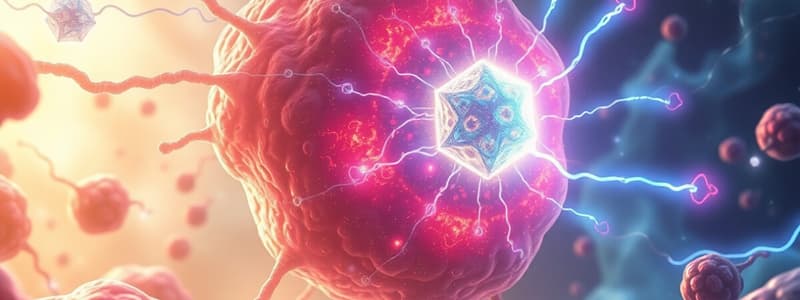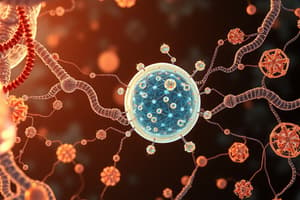Podcast
Questions and Answers
What is the primary function of hormone or ligand binding to a receptor?
What is the primary function of hormone or ligand binding to a receptor?
- To trigger a series of events within the cell (correct)
- To inhibit cell growth
- To initiate cell apoptosis
- To allow cell division
What type of signaling involves the release of hormones into the bloodstream?
What type of signaling involves the release of hormones into the bloodstream?
- Cellular signals
- Endocrine signals (correct)
- Paracrine signals
- Auto signals
Which of the following types of ligands completely blocks the effect of an agonist?
Which of the following types of ligands completely blocks the effect of an agonist?
- Partial agonist
- Agonist
- Antagonist (correct)
- Second messenger
What type of receptor uses a phosphorylation cascade for signaling?
What type of receptor uses a phosphorylation cascade for signaling?
How do second messengers affect cellular response?
How do second messengers affect cellular response?
What is the role of effectors in the cellular signaling process?
What is the role of effectors in the cellular signaling process?
In the context of receptor activation, what happens to a receptor after hormone binding?
In the context of receptor activation, what happens to a receptor after hormone binding?
What is a characteristic of GPCRs in cellular signaling?
What is a characteristic of GPCRs in cellular signaling?
What happens to the Ga subunit after it binds to GTP?
What happens to the Ga subunit after it binds to GTP?
Which G protein is responsible for activating adenylate cyclase?
Which G protein is responsible for activating adenylate cyclase?
What is the primary function of the second messenger cyclic AMP (cAMP)?
What is the primary function of the second messenger cyclic AMP (cAMP)?
What structural feature of GPCRs allows them to transmit signals across the cell membrane?
What structural feature of GPCRs allows them to transmit signals across the cell membrane?
How does the activation of rhodopsin contribute to vision in dim light?
How does the activation of rhodopsin contribute to vision in dim light?
What effect does the hydrolysis of GTP by the Ga subunit have on its activity?
What effect does the hydrolysis of GTP by the Ga subunit have on its activity?
Which of the following is true regarding the G-protein cycle?
Which of the following is true regarding the G-protein cycle?
In the context of the GPCR signaling pathway, what role does the beta-gamma subunit play?
In the context of the GPCR signaling pathway, what role does the beta-gamma subunit play?
Flashcards are hidden until you start studying
Study Notes
Signals & Cell Communication
- Signals initiate communication between cells, allowing for complex processes in multicellular organisms.
- Signals are secreted by cells and can either diffuse locally or circulate throughout the body.
- There are three main types of signaling:
- Endocrine: Hormones released by endocrine glands travel far distances via the bloodstream.
- Paracrine: Signals released by cells diffuse locally and act on neighboring cells.
- Autocrine: Signals act on the same cell that released them.
Receptor Activation
- Receptors are proteins that bind to specific ligands, initiating cellular responses.
- Ligands bind to the extracellular domain of receptors, activating them.
- Receptor activation induces conformational changes, leading to signal transduction.
Receptor Types
- There are three main types of receptors:
- G Protein-Coupled Receptors (GPCRs): Utilize G proteins and second messengers for signaling.
- Receptor Tyrosine Kinases (RTKs): Utilize phosphorylation cascades for signal transduction.
- Ligand-Gated Ion Channels (LGICs): Directly control ion flow across the cell membrane.
Signal Amplification & Second Messengers
- Signal transduction pathways amplify initial signals, enabling a robust response.
- Second messengers, such as cAMP and calcium ions, amplify signaling cascades.
- G proteins act as signal transducers, binding GDP in their inactive state and GTP in their active state.
- G proteins are involved in activating or inhibiting downstream effectors, such as adenylyl cyclase.
GPCR Signaling Pathway
- G protein-coupled receptors (GPCRs) are the largest family of cell surface receptors, responding to a diverse range of signals.
- GPCRs contain three intracellular loops (ICLs) and three extracellular loops (ECLs).
- ECLs bind extracellular signals, while ICLs mediate interaction with G proteins.
- GPCR activation results in exchange of GDP for GTP on the alpha subunit of the G protein.
- GTP-bound alpha subunit dissociates from beta-gamma subunit and activates downstream effectors.
Adenylyl Cyclase (AC) & cAMP
- Adenylyl cyclase (AC) is a key effector protein in the GPCR pathway.
- AC is activated by Gs proteins and inhibited by Gi proteins.
- AC catalyzes the conversion of ATP to cyclic AMP (cAMP).
- cAMP acts as a second messenger, activating protein kinase A (PKA).
Protein Kinase A (PKA)
- PKA is activated by cAMP, leading to phosphorylation of downstream targets.
- PKA phosphorylation can activate or inhibit proteins, regulating cellular processes.
Visual Signaling
- Light perception involves photoreceptor cells in the retina.
- Rods are photoreceptor cells responsible for dim light vision.
- Rhodopsin, a GPCR in rods, absorbs light and undergoes conformational changes.
- Rhodopsin activation triggers a signaling cascade involving transducin, a G protein, and phosphodiesterase, leading to changes in membrane potential and visual signal transmission.
Studying That Suits You
Use AI to generate personalized quizzes and flashcards to suit your learning preferences.




